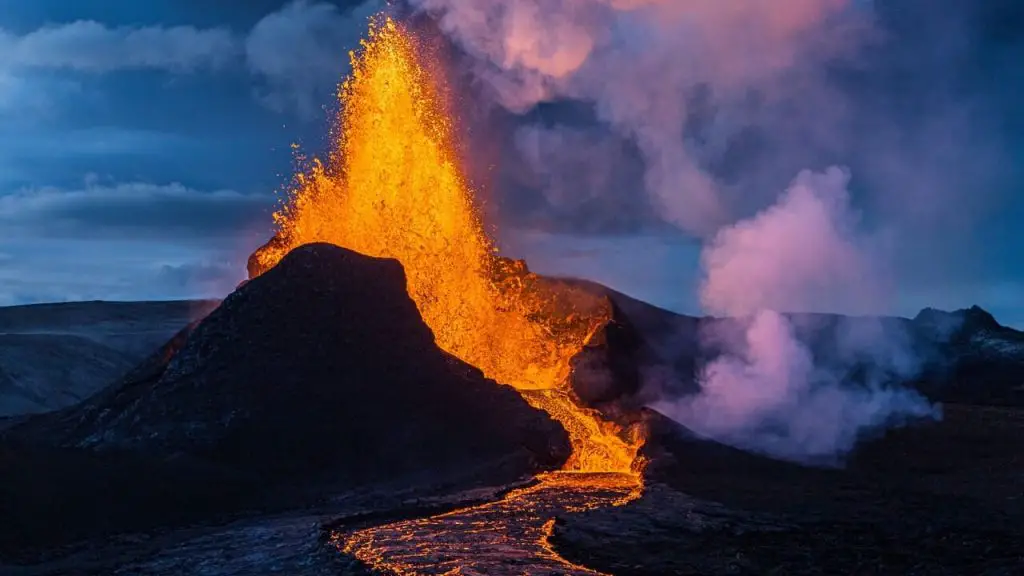Volcanoes are natural phenomena capable of producing tremendous destruction, but also striking beauty. These peaks shoot up from the earth as a result of magma and gas pressure building up below the surface. When this pressure is unable to escape through fissures in the ground, it forces its way out in explosive eruptions. Volcanoes can erupt for minutes or weeks, so there’s no one set answer to how long can a volcano erupt.
Some volcanoes continue their eruption for years on end while others have only had a few explosive eruptions throughout history. This is because every volcano has different characteristics that determine how long it might erupt. However, most volcanoes have an average eruption time of between 10 minutes and a week!
Factors That Determine The Length of An Eruption
Here are some factors that determine the length of an eruption:
1. The Type of Volcano

The type of volcano is the first major factor in how long a volcano can erupt. There are three main types of volcanoes. The type of volcano can determine how long a volcano will erupt because of the varying amount of pressure needed to escape. Hydrothermal volcanoes need less pressure than both other types of volcanoes to erupt. They’re located in areas where there’s a large amount of water below the surface, such as the Pacific Ring of Fire.
This water heats up and builds pressure that’s easily released as an explosion. Hydrothermal explosions can last from just a few minutes to a couple of hours. During a subduction-related eruption, a volcano erupts along a fault line (called a transform fault). They are usually located at the edge of a tectonic plate and are often found in the Caribbean and South America.
Finally, magmatic volcanoes create the most pressure when building up inside the earth. There’s a large amount of magma below the surface that needs to escape as a result of tectonic plates moving and causing a build-up of pressure. An eruption of a magmatic volcano can last for weeks and months, or even years!
2. How Long Can a Volcano Erupt?
Volcanic activity is the rate at which a volcano is erupting. It’s measured on a scale of 0 to 8 and determines the amount of time an eruption will last. Volcanic activity 0 means the volcano is dormant, there’s no movement below the surface. The volcanic activity of 1 means there’s some movement and earthquakes nearby.
An eruption of volcanic activity 2 would be a small amount of ash in the air. The volcanic activity of 3 means the eruption is explosive and the frequency of the eruption is high. This level of activity usually lasts between a few hours and a couple of days.
3. Which Channels Are Blocked?
Most volcanoes have more than one escape route for the gas and pressure below the surface. Different types of volcanoes have different numbers of channels, but all of them have one or more. These channels are usually blocked by lava flows or ash. Volcanoes with multiple channels can release their pressure in several different ways.
This can include lava flowing out of one channel and ash out of another. There’s also the possibility of a mix of explosion and lava flow. The amount of pressure each channel has built up determines the type of eruption the volcano has.
4. How Much Magma Is Involved?
The amount of magma present in the volcano during the eruption can determine the speed at which the eruption progresses. Magma is the melted rock below the surface that’s responsible for the eruption. The amount of magma released into the channels determines how long the eruption will last.
Magma is usually released over a period of days, weeks, or months. The amount of molten rock determines how many eruptions the volcano has in a year.
5. The Volcano’s Location and Environment
The location of the volcano and the environment surrounding it may determine how long a volcano erupts. If the volcano is in a densely populated area, the duration of the eruption may be shorter than one located in a remote location. Volcanic eruptions are monitored by volcanologists who can forecast the length of an eruption based on previous patterns regarding wind, pressure, and lava flow.
Eruptions near population centers can be stopped or controlled once the scientists have collected enough data. However, eruptions in remote areas are difficult to forecast and stop because of the lack of technology.
Final Words
Volcanoes are natural phenomena that can produce both striking beauty and tremendous destruction. These peaks shoot up from the earth as a result of magma and gas pressure building up below the surface. When this pressure is unable to escape through fissures in the ground, it forces its way out in explosive eruptions.
How Long Can a Volcano Erupt? Well, it depends on the type of volcano and the type of eruption. Volcanic activity, the amount of pressure below the surface, and the amount of magma present can determine how long a volcano erupts. The location and environment surrounding the volcano can also play a role in the length of an eruption.
Additional Contents:

